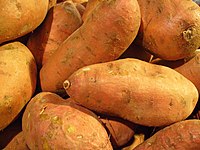
Photo from wikipedia
Abstract High temperature is one of the major abiotic stresses affecting performance of crop plants including potato yield. To gain an insight into whether high temperature effects tuber yield and… Click to show full abstract
Abstract High temperature is one of the major abiotic stresses affecting performance of crop plants including potato yield. To gain an insight into whether high temperature effects tuber yield and its relation to translocation of photoassimilates in potato, a comparative study was conducted using five (Kufri jyoti, Kufri megha, Kufri pokraj, Rangpuria, and Badami) potato cultivars for two consecutive years. These cultivars were sown early in the season (mid August–November) when the temperature was high and normal growing season (ambient condition) (mid October–mid January) in an open field along in a polyhouse where the temperature was high. Early season planting experienced highest temperature (30–35 °C) and temperature in the polyhouse was 2–4 °C higher than the ambient condition. Leaf net CO 2 assimilation rate, stem anatomy, xylem size, sugar-starch ratio, activity of sucrose phosphate synthase, tuber bulking rate and tuber yield were evaluated under all three conditions (early season, ambient condition and polyhouse conditions). Overall, compared to ambient conditions, under early season and polyhouse conditions, the net photosynthesis rate was significantly reduced but sugar starch ratio was significantly enhanced in all tested cultivars. Under both early planting and polyhouse conditions, the xylem cells were abnormally enlarged and deformed in all potato cultivars, however, the effects were minimal in case of cultivar Kufri megha (high yielding cultivar) and Rangpuria (local cultivar) which was correlated with the minimal yield reduction. Overall, the temperature induced abnormalities in vascular tissues appears to be critical for tuber bulking rate and tuber yield (42–55% in the high yielding cultivars and 44–54% in the local cultivars). The cultivars that could maintain xylem size and phloem structure tended to minimize the negative effects of high temperature on tuber yield.
Journal Title: Scientia Horticulturae
Year Published: 2017
Link to full text (if available)
Share on Social Media: Sign Up to like & get
recommendations!